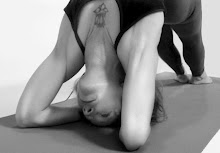Ahimsa, non-harming

Ahimsa, the principle of not harming others, is a difficult practice and one that many think to be impossible to follow. But some have practiced ahimsa successfully; The Buddha, The Christ, Mahatma Gandhi, numerous Saints from many religious traditions, and even secular ones have all managed to live peacefully and co-exist with others even in the face of death.
So how to begin this practice? A Buddhist practice of Vipassana Insight Meditation teaches that first one must begin with oneself. As applied to your Yoga practice, notice your breathing; does it remain slow, steady, and measured? Or does it become shallow and ragged? Uneven? How do your muscles feel in each posture? Do your joints feel strain? Is your weight distributed evenly? Use your powers of observation to adjust your posture, shift your weight, change your breathing accordingly and you will become more comfortable in your practice.
When you get tired, stop and rest! Following the traditional guidelines, do not force your body to do more than you are capable of in each practice session. You should be able to master the first Sun Salutation fully before attempting the second (and be able to perform five to ten in a row). Once you can do this six days in a row with one day off (resting on your back for at least five minutes before going about your day), add on to your practice).
Be sure to notice how you feel throughout your day as well as the next morning. If you feel thoroughly trashed, you know you did too much and should do less the next day. Don't be harmful to yourself by overworking your body, you will only end up making yourself sick or injured. It is better to do less and increase gradually than to do too much and set yourself back.
Once you have mastered the principle of being non-violent with yourself, you can begin to practice this with those you love - your family, your friends. Surely you remember times (holiday meals, stressful times....) when someone said something that escalated out of control and somehow people ended up not speaking to each other for a time. By looking deeply into your own heart first and then by being able to put yourself into another's heart before engaging the mouth one can practice slowing down and finding other ways of expressing concepts that are less harmful and disturbing. By looking at patterns which lead up to conflict and learning to defuse the patterns, one can avoid the conflict entirely! Moving on to those you are merely acquainted with, having neutral feelings for is the next step.
Having mastered this, one can then attempt the most difficult practice of all: focusing on those who hate or do violence. This is truly the path of divine love. Feeling love for those who hate you is not a practice for beginners. It may take many years of meditation at the level of the self before you can begin to move to the level of friends and family, but less time to move up to acquaintances. But loving those who have hate against you, especially if you ever lost a loved one to such a person requires a heroic effort.
This is why Ahimsa is the first Yama, or Limb, of Ashtanga Yoga. It is the most important leaf on the Limb of the Tree of Life; without it, the Tree withers and dies. With it, the Tree bears beautiful flowers and fruits which feeds the human family and sends a wonderful fragrance into the air while giving us shade and shelter.


2 Comments:
thanks for sharing. Your words are as good as your yoga classes. your yoga classes are the best!
Yes, ahimsa is so important and like you said, we must start with ourselves - as every action we perform affects us first. But, I think that all the limbs of yoga give life to the tree. Thanks for this blog.
Post a Comment
<< Home